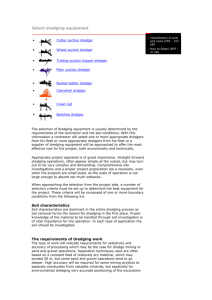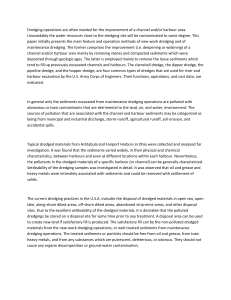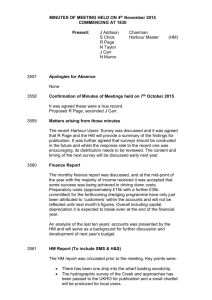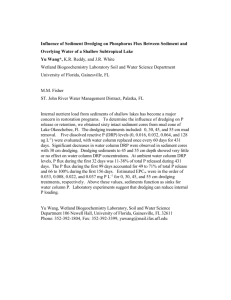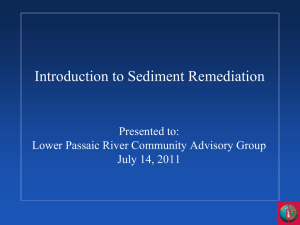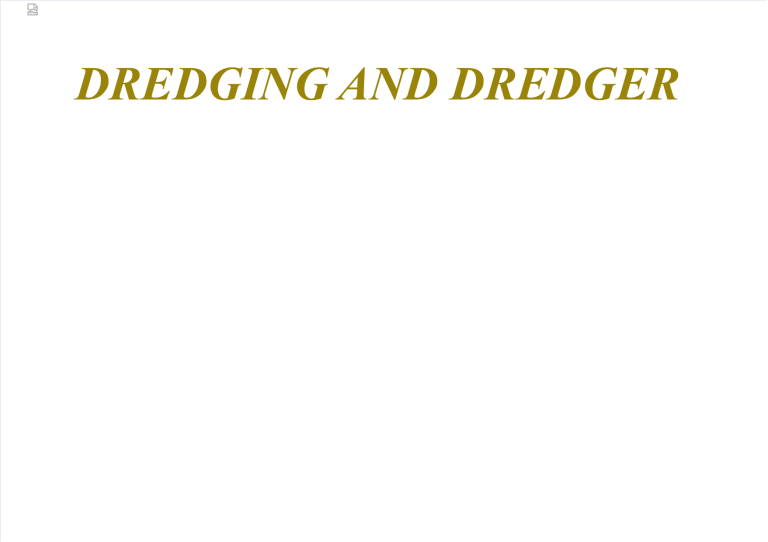
DREDGING AND DREDGER DREDGING Dredging is an excavation activity or operation usually carried out at least partly underwater, in shallow seas or fresh water areas with the purpose of gathering up bottom sediments and disposing of them at a different location. This technique is often used to keep waterways navigable. It is also used as a way to replenish sand on some public beaches, where too much sand has been lost because of coastal erosion. Dredging is also used as a technique for fishing for certain species of edible clams and crabs, see fishing dredge. Dredging is an important way of providing sands and gravels for construction and reclamation projects. In the last two decades, the demand, and the associated extraction rates, for such offshore aggregates have significantly increased. To establish and maintain navigation channels and harbors of sufficient size to accommodate shipping vessels. A dredge is a device for scraping or sucking the seabed, used for dredging. A dredger is a ship or boat equipped with a dredge. The terms are sometimes interchanged. These schemes are designed to prevent – or reduce the likelihood of – erosion or flooding. Such beach nourishment or recharge is achieved by placing dredged sand or gravel on eroding beaches. This represents a “soft-engineering” solution, an important alternative to – often more costly – structural solutions such as rock armour or concrete walls. USES OF DREDGING Capital: dredging carried out to create a new harbour, berth or waterway, or to deepen existing facilities in order to allow larger ships access. Because capital works usually involve hard material or high-volume works, the work is usually done using a cutter suction dredge or large trailing suction hopper dredge, but for rock works drilling and blasting along with mechanical excavation may be used. Flood prevention: this can help to increase channel depth and therefore increase a channel's capacity for carrying water. Peat extraction: in former times, so-called dredging poles or dredge hauls were used on the back of small boats to manually dredge the beds of peat-moor waterways before extracting the peat for use as a fuel. This tradition has now become more or less obsolete and the tools used to do this have also changed significantly. Preparatory: work and excavation for future bridges, piers or docks/wharves, often connected with foundation work. Maintenance: dredging to deepen or maintain navigable waterways or channels which are threatened to become silted with the passage of time, due to sedimented sand and mud, possibly making them too shallow for navigation. This is often carried out with a trailing suction hopper dredge. Most dredging is for this purpose, and it may also be done to maintain the holding capacity of reservoirs or lakes Land reclamation: dredging to mine sand, clay or rock from the seabed and using it to construct new land elsewhere. This is typically performed by a cutter-suction dredge or trailing suction hopper dredge. The material may also be used for flood or erosion control. Beach nourishment: mining sand offshore and placing on a beach to replace sand eroded by storms or wave action. This is done to enhance the recreational and protective function of the beaches, which can be eroded by human activity or by storms. This is typically performed by a cutter-suction dredge or trailing suction hopper dredge. Harvesting materials: dredging sediment for elements like gold, diamonds or other valuable trace substances. Seabed mining: a possible future use, recovering natural metal ore nodules from the sea's abyssal plains. Construction materials: dredging sand and gravels from offshore licensed areas for use in construction industry, principally for use in concrete. Very specialist industry focused in NW Europe using specialized trailing suction hopper dredgers self discharging dry cargo ashore. Anti-eutrophication: Dredging is an expensive option for the remediation of eutrophied (or de-oxygenated) water bodies. However, as artificially elevated phosphorus levels in the sediment aggravate the eutrophication process, controlled sediment removal is occasionally the only option for the reclamation of still waters. Contaminant remediation: to reclaim areas affected by chemical spills, storm water surges (with urban runoff), and other soil contaminations. Disposal becomes a proportionally large factor in these operations. Removing trash and debris: often done in combination with maintenance dredging, this process removes non-natural matter from the bottoms of rivers and canals and harbors. Environmental impacts Release of toxic chemicals (including heavy metals and PCB) from bottom sediments into the water column. Short term increases in turbidity, which can affect aquatic species metabolism and interfere with spawning. Secondary effects from water column contamination of uptake of heavy metals, DDT and other persistent organic toxins, via food chainuptake and subsequent concentrations of these toxins in higher organisms including humans. Secondary impacts to marsh productivity from sedimentation Tertiary impacts to avifauna which may prey upon contaminated aquatic organisms Secondary impacts to aquatic and benthic organisms' metabolism and mortality Possible contamination of dredge spoils sites PROCESS OF DREDGING The dredging process consists of the following three elements: Excavation • Transport of excavated material • Utilization or disposal of dredged material • Excavation: This process involves the dislodgement and removal of sediments (soils) and/or rocks from the bed of the water body. A special machine - the dredger – is used to excavate the material either mechanically, hydraulically or by combined action. Transport of excavated material: Transporting materials from the dredging area to the site of utilization, disposal or intermediate treatment, is generally achieved by one of the following methods: (a) in self-contained hoppers of the dredgers; (b) in barges; (c) pumping through pipelines; and (d) using natural forces such as waves and currents. Other, rarely used transport methods are truck and conveyor belt transport. The method of transport is generally linked to the type of dredger being used. Utilization or disposal of dredged material: In construction projects, dredging is driven by the demand for dredged material. In navigation and remediation dredging, the project is driven by the objective of removing the material from its original place. Types of Dredger Mechanical dredgers Hydraulic dredgers Airlift dredgers Special, low-impact dredgers and The selection of dredging equipment for a particular project will depend upon a combination of factors, including: the type of physical environment; the nature, quantity and level of contamination of the material to be dredged; the method of placement; and the distance to the placement site. Mechanical dredger: Three main sub-groups of mechanical dredger can be identified: bucket-ladder dredgers; backhoes; and grab dredgers. Mechanical dredges use a bucket-like apparatus to scoop up material and dump it either on a temporary barge or directly onto a disposal site. They can work in confined areas, such as small harbors or around docks and piers, and they are most suited to removing hard packed sediment. A mechanical dredge easily removes large pieces of rock, but fine sediment tends to wash out of the bucket as it is being raised through the water. Clam shell dredges and dipper dredges are the most common types of mechanical dredges. Hydraulic Dredger Three main sub-groups of hydraulic dredger are: stationary suction dredgers; cutter suction dredgers; and trailing suction hopper dredgers. These dredgers use hydraulic centrifugal pumps to provide the dislodging and lifting force and remove the material in a liquid slurry form. They usually work well in loose, “unconsolidated” silts, sands, gravels and soft clays. In more cohesive materials teeth or waterjets may be applied for breaking up the material. Transport methods associated with hydraulic dredgers are pipeline and hopper transport. In some cases, hydraulic dredgers may pump the materials into barges for transport. Special low-impact (environmental/restoration") dredgers: It is increasingly important to dredge contaminated sediments in an environmentally acceptable manner, in particular ensuring that contaminants are not re-mobilised and/or released into the water column where they may detrimentally affect aquatic life. A new range of equipment has therefore been developed with the aim of increasing precision, i.e by reducing overdredging, and minimising the suspension of bed material. In some cases existing dredger types have been modified; in other cases completely new dredgers have been designed. Examples include the following: encapsulated bucket lines for bucket chain dredgers; closed buckets for backhoes; closed clamshells for grab dredgers; auger dredger, disc cutter, scoop dredger and sweep dredger (all modified cutter dredgers). Airlift dredger: Airlift dredges use hydrostatic pressure to raise material off the bottom into a piston-like cylinder. Once the cylinder is full of sediment, compressed air pushes the material through a pipe to a temporary barge or a disposal site. Airlift dredges are not commonly used in the U.S., but they are well-suited for removing contaminated sediments, since very little water mixes with the dredged sediments. Types of Dredging Vessels: Snag boat - Used to break up logjams and to clear debris, sunken vessels, and dilapidated piers that may be hazards Mechanical - Dipper dredge and clamshell dredge removes hard packed material or debris cannot handle fine-grained sediment, such as silt or sand - places materials into barges for transport to disposal sites us to navigation. self-propelled hopper dredge: - stores sediment within vessel for disposal later at approved site - works in deep water (primarily in harbors and ports) - cannot dredge continuously - can operate in rough water dustpan dredge and sidecaster dredge - used to remove loosely compacted coarse-grained material at rapid shoaling sites or where sediment is needed adjacent to a navigation channel. Types of Disposal side Ocean Placement - off-shore site approved by Environmental Protection Agency for disposal - hopper dredge or towed barge with material from inlets, bars, and main approaches - vessel opens hull and allows sediment to drift to bottom of ocean Beach Nourishment placement of material on or near a beach - usually to replenish an eroding beach typically done with pipeline and hopper dredges Upland Placement - placement of material directly into a diked area, usually by pipeline dredge - generally the most economical method of dredging Open Water Placement - placement of dredged materials in near-coastal or inland waters - may include contaminated materials placed in deep pits or bottom depressions - material is capped in a precisely engineered manner to ensure cap stays in place and isolates material from environment. Within Banks Placement - generally occurs on river system - material is placed on banks or downstream of shoals along shoreline material, usually coarse-grained sand can be used commercially Other dredging vessels are: Police drag Fishing Submersible Amphibious Krabbelaar Bed leveler Pneumatic Water injection Backhoe/dipper Grab Bucket Effect of dredging process: water quality, e.g. increase of suspended solids concentration and potential release of contaminants during dredging or disposal; leaching of contaminants from disposal sites; • habitats and natural areas, e.g. habitat enhancement or creation, removal or destruction of benthos, smothering; • local communities, e.g. the effects of noise; increased labour opportunities; • changes to bathymetry or topography; • physical processes, e.g. waves, currents, or drainage, and hence erosion or deposition; • archaeological assets, e.g. shipwrecks; • recreation, e.g. sailing, swimming and beach use; • economic activities, e.g. commercial fishing; improved infrastructure. Responsible agencies of dredging Corps of Engineers for navigation channels Port Authorities for harbors THANK YOU
